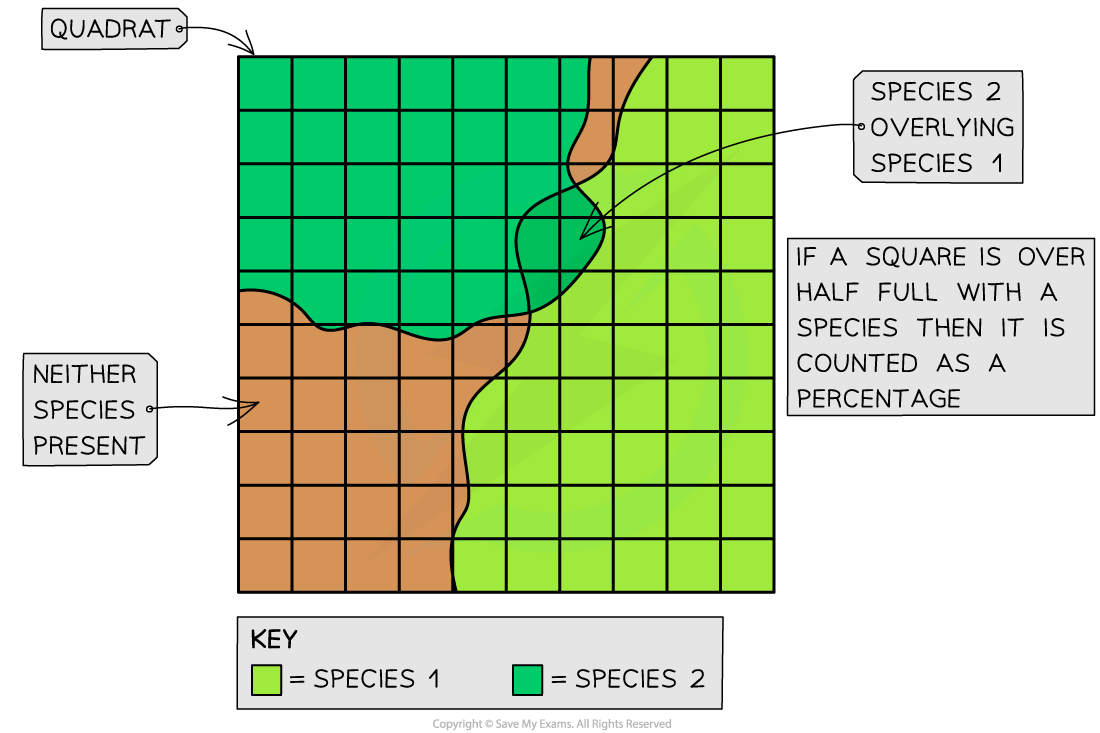Syllabus Edition
First teaching 2015
Last exams 2025
Measuring Biotic Components of Ecosystems (DP IB Environmental Systems & Societies (ESS)) : Revision Note
Measuring Biotic Components of Ecosystems
Measuring all the different levels of biodiversity within an ecosystem could be very time-consuming
Finding out which species live in an ecosystem and the size of the populations requires the identification and cataloguing of all organisms present to build a species list
This is possible for areas that are very small or where the species are very large like trees
However, for larger and more complex ecosystems like rainforests, it is simply impossible to find, identify and count every organism that exists there
When this is the case different samples of the area can be taken and used to make an estimate for the total species numbers in the area
Quadrats
Quadrats are square frames made of wood or wire
They can be a variety of sizes eg. 0.25m2 or 1m2
They are placed on the ground and the organisms within them are recorded
Non-motile organisms such as plants species are commonly studied using quadrats to estimate their abundance
Quadrats can be used to measure abundance by recording:
The number of an individual species: the total number of individuals of a single species (eg. daisies) is recorded
Species richness: the total number of different species (but not the number of individuals of each species) is recorded
Percentage cover: the approximate percentage of the quadrat area in which an individual species is found is recorded (this method is often used when it is difficult to count individuals of the plant species being recorded eg. grass or moss)

Using a quadrat to investigate population size or distribution

Using a quadrat to investigate percentage cover of two species of grass. There may be some squares lacking any species and other squares with multiple species - this means the total percentage cover of a single quadrat can sometimes be over or under 100%
Estimating Population Size
Quadrats must be laid randomly in the area to avoid sampling bias
This random sampling can be done by converting the sampling area into a grid format and labelling each square on the grid with a number
Then a random number generator is used to pick the sample points
Once the quadrat has been laid on the chosen sample point the abundance of all the different species present can be recorded
How to estimate the population size of a plant species in a survey area
Estimating percentage frequency and percentage cover
The results from the quadrats can be used to calculate the predicted frequency and density of a species within an area
Species frequency is the probability that the species will be found within any quadrat in the sample area
The number of quadrats that the species was present in is divided by the total number of quadrats and then multiplied by 100
For example, if bluebells were found in 18 out of 50 quadrats the species frequency would be (18/50) x 100 = 36%
Species density indicates how many individuals of that species there are per unit area
The number of individuals counted across all quadrats is divided by the total area of all the quadrats
For example, if 107 bluebells, a common woodland plant, were found across 50 quadrats that are 1m2 each the species density would be 107/50 = 2.14 individuals per m2
It can sometimes be difficult to count individual plants or organisms. When this is the case percentage cover of the species within the quadrat can be estimated instead
The quadrat is divided into 100 smaller squares. The number of squares the species is found in is equivalent to its percentage cover in that quadrat
For example, if grass is found in 89 out of 100 squares in the quadrat then it has a percentage cover of 89%

How to estimate the percentage cover of one or more species using a quadrat
Limitations of Using Quadrats
It can be easy to miss individual organisms when counting in a quadrat, especially if they are covered by a different species
Solution: Use a pencil or stick to carefully move leaves out of the way to check if there is anything else underneath
Identifying species may be tricky
Solution: Use a species key to identify the species
Direct methods for estimating the abundance of motile organisms
Quadrats are suitable for sampling plants or slow-moving animals
For many animal species, however, it is not possible to use quadrats to measure their distribution and abundance
In these cases, other techniques involving other items of equipment are necessary, including:
Sweeping nets: these are large, strong nets with a fine material (very small holes) that are used to catch flying insects and insects that live in long grass by sweeping the net back and forth through the grass
Pitfall traps: these are cans or jars that are buried in the ground that are used to catch ground-dwelling (often nocturnal) insects and other invertebrates as they fall into the trap
Pooters: these are small plastic or glass containers with two tubes sticking out that are used to suck up small insects and other small invertebrates. The first tube is placed over the insect and the second tube is used by the scientist to create suction
Tullgren funnel: these are funnels with a light bulb above and a container below that are used to collect invertebrates that live in leaf litter or soil. The leaf litter or soil is placed in the funnel and the light and heat forces the invertebrates to move down until they drop into the container
Kick-sampling: this technique is used to catch freshwater invertebrates living in streams or rivers. A net in placed on the stream-bed so that the water is flowing into it and the stream-bed just above the net is churned up by the scientist (using their foot) for a set period of time. The invertebrates are carried by the stream into the net

An example of how a pitfall trap can be used

An example of how a pooter can be used

An example of how a Tullgren funnel can be used

Example of how kick-sampling is done
Indirect method for estimating abundance of motile organisms: mark-release-recapture
The sampling methods described above are only useful for non-motile (sessile) organisms
Different methods are required for estimating the number of individuals in a population of motile animals (i.e. animals that are mobile)
The mark-release-recapture method is commonly used alongside the Lincoln Index (a statistical measure used to estimate population size)
For a single species in the area:
The first large sample is taken - as many individuals as possible are caught, counted and marked in a way that won’t affect their survival e.g. if studying a species of beetle, a small amount of brightly coloured non-toxic paint can be applied to their carapace (shell)
The marked individuals are returned to their habitat and allowed to randomly mix with the rest of the population
When a sufficient amount of time has passed another large sample is captured
The number of marked and unmarked individuals within the sample are counted
The proportion of marked to unmarked individuals is used to calculate an estimate of the population size (the Lincoln Index, N)
The formula for calculating the Lincoln Index is:
Where:
n1 = the number caught in the first sample (i.e. the number of marked individuals released)
n2 = number of individuals caught in the second sample (marked and unmarked)
nm = number of marked individuals in the second sample
Worked Example
Scientists wanted to investigate the abundance of leafhoppers in a small grassy meadow. They used sweep nets to catch a large sample of leafhoppers from the meadow. Each insect was marked on its underside with non-toxic waterproof paint and then released back into the meadow. The following day another large sample was caught using sweep nets. Use the figures below to estimate the size of the leafhopper population in this meadow.
No. caught and marked in first sample (n1) = 236
No. caught in second sample (n2) = 244
No. of marked individuals in the second sample (nm) = 71
Answer
Step One: Write out the equation and substitute in the known values
N = (n1 × n2) ÷ nm
N = (236 × 244) ÷ 71
Step Two: Calculate the population size estimate (N)
N = 57,584 ÷ 71
N = 811
N (estimated population size) = 811
Limitation of Using Mark-release-recapture
When using the mark-release-capture method, there are a few assumptions that have to be made:
The marked individuals must be given sufficient time to disperse and mix back in fully with the main population - this can be time-consuming
The marking doesn't affect the survival rates of the marked individuals (e.g. doesn't make them more visible and therefore more likely to be predated)
The marking remains visible throughout the sampling and doesn't rub off - this is often difficult to ensure and so the accuracy of population size estimates may be negatively affected
The population stays the same size during the study period (i.e. there are no significant changes in population size due to births and deaths and there are no migrations into or out of the main population) - again, this is almost impossible to ensure, further affecting the accuracy of population size estimates
Examiner Tips and Tricks
You will be provided with the formula for Lincoln’s index in the exam. You need to be able to carry out the calculation to estimate population size from mark-capture-release data, as you could be asked to do this in the exam.

You've read 0 of your 5 free revision notes this week
Sign up now. It’s free!
Did this page help you?

